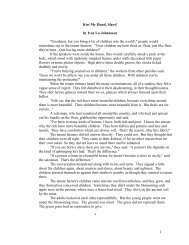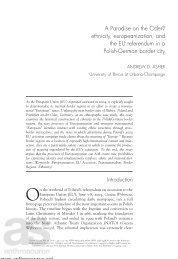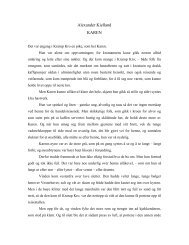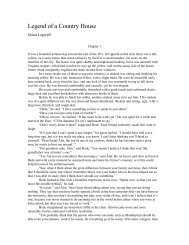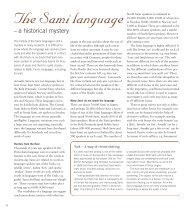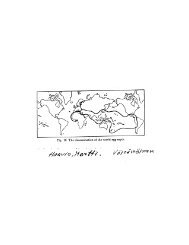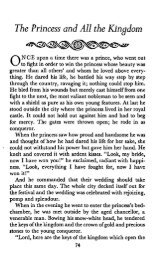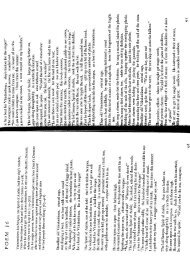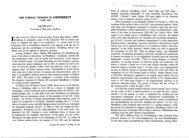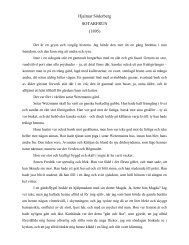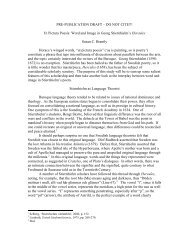Six Views of “The Little Mermaid” - Department of Scandinavian ...
Six Views of “The Little Mermaid” - Department of Scandinavian ...
Six Views of “The Little Mermaid” - Department of Scandinavian ...
You also want an ePaper? Increase the reach of your titles
YUMPU automatically turns print PDFs into web optimized ePapers that Google loves.
144 SCANDINAVIAN 3 1 U UICS<br />
Girlhood<br />
Childhood<br />
No fragrance<br />
No sexuality’<br />
Femininity<br />
Womanhood<br />
Adulthood<br />
Fragrance<br />
Sexuality<br />
Masculinity<br />
The movement between the binary oppositions in the text can be<br />
illustrated as follows:<br />
Lfe in the Sea World, .<br />
’+Life in the Land World’<br />
The following represents the binary oppositions that form the basic dualism<br />
at the end <strong>of</strong> the story.<br />
Univmd Order<br />
Order <strong>of</strong> the Humans Order <strong>of</strong> the Air Spirits<br />
Innate immortality Acquired immortality<br />
Higher World Highest World<br />
Humans Air spirits<br />
Sexuality Spirituality<br />
Fragrance Distributor <strong>of</strong> Fragrance<br />
No demands Demands<br />
Masculinity Femininity<br />
The movement between the binary oppositions can be illustrated as follows:<br />
Life <strong>of</strong> Humuns \<br />
\<br />
Immortal Life’<br />
A<br />
I<br />
I<br />
Life <strong>of</strong> the Aii Spirits<br />
The model asserts that a movement between two conditions always<br />
takes place in two phases. First one movement that removes or negates the<br />
first condition, hereafter a movement that establishes another condition.<br />
Conclusion<br />
Structuralism is very goal-directed; it takes a direct approach to unveil the<br />
central meaning and structure <strong>of</strong> a text.<br />
In the actantial model the enterprise <strong>of</strong> the mermaid is pointed out and<br />
the forces working for her and against her are clarified. The contract model<br />
highlights the process <strong>of</strong> the story from the beginning to the very end. The<br />
S-model focuses on the two possible conditions that the sto relates to and<br />
tells about: mortality versus immortality. We have moved 7 rom a cause <strong>of</strong><br />
>PLASH! 145<br />
events <strong>of</strong> a more or less manifold character to some hidden law that can be<br />
captured in simple models. The argument can therefore be made that this<br />
story has a world view that is based on binary oppositions.<br />
Notes<br />
’ This is how I interpret fish tails versus legs.<br />
* The line is broken because the mermaid does not succeed in achieving human life.<br />
’ The line is broken because we do not know within the framework <strong>of</strong> the story whether<br />
or not the mermaid achieves immortality.<br />
A Psychoanalytic Approach<br />
Sabrina Soracco<br />
Berkeley, California<br />
TRADITIONAL psychoanalytic approach to a literary text employs the<br />
tenets <strong>of</strong> classical psychoanalysis, developed by Freud and further<br />
A elaborated on, and modified by, his followers. One <strong>of</strong> the more<br />
significant aspects <strong>of</strong> Freudian theory and that which has come under<br />
greatest critique from post-Freudian feminist psychoanalytic theory is<br />
Freud’s notion <strong>of</strong> the Oedipal complex. The main objection to Freud’s<br />
theories on female psychosexual development, which are outlined in his<br />
three essays “Some Psychical Consequences <strong>of</strong> the Anatomical Distinction<br />
Between the Sexes” (1925), “Female Sexuality” (1931), and “Femininity”<br />
(1933), revolves around Freud’s insistence that women are born physically<br />
castrated. According to Freud, the little girl blames the mother for her own<br />
castration and turns to the father as the person who can provide her with<br />
the phallus she is lacking. Unable to gain access to the father because <strong>of</strong> the<br />
incest taboo, Freud maintains that the female desire for the hallus is<br />
transformed into the desire for a baby, preferably a boy. This Oe ipal crisis<br />
is suppressed during the period <strong>of</strong> latency and reemerges at puberty, B when<br />
the Oedipal desire resurfaces and is displaced from the father onto other<br />
male figures. Post-Freudian object theorists such as Nancy Chodorow would<br />
maintain that it is not only the Oedipal but also the pre-Oedipal conflicts<br />
that reemerge at prepuberty and adolescence and that the adolescent girl,<br />
more so than the boy, must struggle with greater issues <strong>of</strong> separation from<br />
the pre-Oedipal mother. Using a psychoanalytic framework, one might<br />
interpret “Den lille Havfrue” as an attempt on the part <strong>of</strong> the mermaid to<br />
work through the Oedipal conflict characteristic <strong>of</strong> the adolescent phase.<br />
The mermaid’s desire to leave the female dominated mer-world is<br />
already anticipated in her garden, which has as its center a male statue<br />
resembling the prince. The desire <strong>of</strong> the little mermaid to leave the<br />
mer-world, the world <strong>of</strong> the pre-Oedipal mother, dominates the initial part<br />
<strong>of</strong> the story. On her fifteenth birthday, she, like her sisters, travels to see<br />
the human world. While the journey to the higher world satisfies the<br />
-



